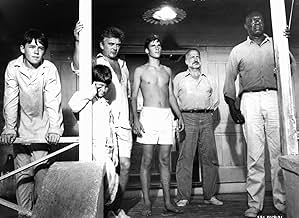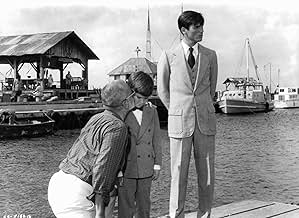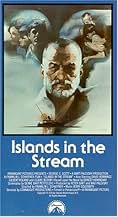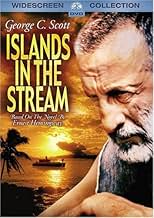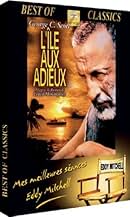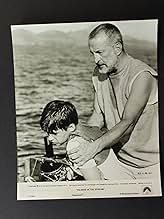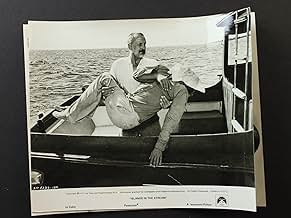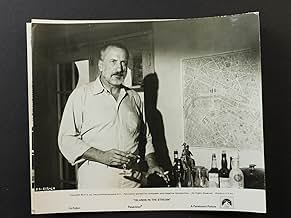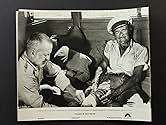AVALIAÇÃO DA IMDb
6,5/10
1,7 mil
SUA AVALIAÇÃO
Adicionar um enredo no seu idiomaAn isolated sculptor is visited by his three sons just before the start of WWII.An isolated sculptor is visited by his three sons just before the start of WWII.An isolated sculptor is visited by his three sons just before the start of WWII.
- Direção
- Roteiristas
- Artistas
- Indicado a 1 Oscar
- 4 indicações no total
- Direção
- Roteiristas
- Elenco e equipe completos
- Produção, bilheteria e muito mais no IMDbPro
Avaliações em destaque
With Islands In The Stream, George C. Scott took his place as an existential Hemingway hero along side such Hollywood luminaries as Gary Cooper, Humphrey Bogart, Gregory Peck, Spencer Tracy, Tyrone Power and Rock Hudson. With that beard he grew for the film he even looks the part of Hemingway.
In this partially autobiographical novel it's first set in the Bahamas where Scott, a painter has gone to get away from the rest of the world. He fishes, he consorts with loose women, and when he's got time and a need for cash, he paints and sells the product to keep going. It sounds like an ideal existence.
Unfortunately World War II intervenes and his three sons by different women all visit him. The oldest, Hart Bochner, has made his mind up to enlist in the Royal Air Force. The two youngest go back to Europe.
One of Scott's good friend is charter boat captain Gilbert Roland who has a side living smuggling refugees, mostly Jews, from Europe to any place in the western hemisphere he can drop them off. A lot times that's Cuba, but the Cuban government is taking a dim view of his activities.
Scott also has as two good friends, native Bahamian Julius Harris, and David Hemmings a young man with a drinking problem. Hemmings's character is ripped off from Hemingway's previous story, To Have and Have Not although Walter Brennan was a good deal older. He even used the same name.
Claire Bloom is also around as the first wife who visits after their son leaves for service. Scott still loves her in his own way, but she's well aware of his fidelity problem. To remind them both is working girl Susan Tyrell.
Ernest Hemingway wrote the story in the early Fifties and discarded it and his widow published it in the early seventies. Probably Papa Hemingway didn't think all that much of it. It certainly doesn't rate with some of his better known work. But second rate Hemingway is better than first rate from most writers.
The cast all give uniformly good performances and the cinematography is just great. Reason enough to see it.
In this partially autobiographical novel it's first set in the Bahamas where Scott, a painter has gone to get away from the rest of the world. He fishes, he consorts with loose women, and when he's got time and a need for cash, he paints and sells the product to keep going. It sounds like an ideal existence.
Unfortunately World War II intervenes and his three sons by different women all visit him. The oldest, Hart Bochner, has made his mind up to enlist in the Royal Air Force. The two youngest go back to Europe.
One of Scott's good friend is charter boat captain Gilbert Roland who has a side living smuggling refugees, mostly Jews, from Europe to any place in the western hemisphere he can drop them off. A lot times that's Cuba, but the Cuban government is taking a dim view of his activities.
Scott also has as two good friends, native Bahamian Julius Harris, and David Hemmings a young man with a drinking problem. Hemmings's character is ripped off from Hemingway's previous story, To Have and Have Not although Walter Brennan was a good deal older. He even used the same name.
Claire Bloom is also around as the first wife who visits after their son leaves for service. Scott still loves her in his own way, but she's well aware of his fidelity problem. To remind them both is working girl Susan Tyrell.
Ernest Hemingway wrote the story in the early Fifties and discarded it and his widow published it in the early seventies. Probably Papa Hemingway didn't think all that much of it. It certainly doesn't rate with some of his better known work. But second rate Hemingway is better than first rate from most writers.
The cast all give uniformly good performances and the cinematography is just great. Reason enough to see it.
This adaptation of a series of Hemingway stories never fails to be engaging. George C. Scott stars as a sculptor, Thomas Hudson, who lives in a Bahamian island paradise in 1940. The world is on the cusp of WWII, but people like Thomas aren't likely to be deeply affected by it, apart from the Jewish refugees that sometimes turn up on their island. That summer, Thomas is visited by his three sons - Tom (Hart Bochner), Andy (Brad Savage), and Davy (Michael-James Wixted) - whom he's sired with two different wives.
The script, by Denne Bart Petitclerc, follows a three-act structure, as it portrays Thomas' relationship with "The Boys", is visited by Toms' mother (Claire Boom) during "The Woman", and they reminisce about their past, and finally, shows what happens as Thomas and his friends Joseph (Julius Harris) and Eddy (David Hemmings) undertake "The Journey", wherein they act upon a chance to do some good.
Reuniting Scott with his "Patton" director, Franklin J. Schaffner, "Islands in the Stream" is a deliberately paced drama with a pleasant feel to it during its first two thirds, and an almost dream-like quality. Certainly it's very easy on the eyes, with its gorgeous photography of these exotic locations. It's also accompanied by a wonderful Jerry Goldsmith soundtrack. While some viewers might feel that the film goes downhill in its final third, this viewer never lost interest (although, admittedly, "Islands in the Stream" is never better than when it's a story of a father and his sons).
Scott gives one of his most engaging performances of all time, with similarly laudable work by such performers as Harris ("Live and Let Die"), Hemmings ("Deep Red"), Bloom ("The Haunting"), Gilbert Roland ("The Bad and the Beautiful"), Susan Tyrrell ("Forbidden Zone"), and Richard Evans ("Dirty Little Billy"). Bochner (in his feature debut), Savage, and Wixted are very appealing as the sons.
Overall, this is definitely worth a look: a nicely nuanced look at an interesting man - maybe not a truly great man - but who has certainly earned the admiration of his friends and offspring.
Seven out of 10.
The script, by Denne Bart Petitclerc, follows a three-act structure, as it portrays Thomas' relationship with "The Boys", is visited by Toms' mother (Claire Boom) during "The Woman", and they reminisce about their past, and finally, shows what happens as Thomas and his friends Joseph (Julius Harris) and Eddy (David Hemmings) undertake "The Journey", wherein they act upon a chance to do some good.
Reuniting Scott with his "Patton" director, Franklin J. Schaffner, "Islands in the Stream" is a deliberately paced drama with a pleasant feel to it during its first two thirds, and an almost dream-like quality. Certainly it's very easy on the eyes, with its gorgeous photography of these exotic locations. It's also accompanied by a wonderful Jerry Goldsmith soundtrack. While some viewers might feel that the film goes downhill in its final third, this viewer never lost interest (although, admittedly, "Islands in the Stream" is never better than when it's a story of a father and his sons).
Scott gives one of his most engaging performances of all time, with similarly laudable work by such performers as Harris ("Live and Let Die"), Hemmings ("Deep Red"), Bloom ("The Haunting"), Gilbert Roland ("The Bad and the Beautiful"), Susan Tyrrell ("Forbidden Zone"), and Richard Evans ("Dirty Little Billy"). Bochner (in his feature debut), Savage, and Wixted are very appealing as the sons.
Overall, this is definitely worth a look: a nicely nuanced look at an interesting man - maybe not a truly great man - but who has certainly earned the admiration of his friends and offspring.
Seven out of 10.
This is one of the most memorable and moving films I saw in the 70s. Perfectly photographed and gently presented, this drama of a family dissecting how they feel about their artist father and his island atoll existence transports the viewer to genuinely feel as though we have been there as well. I revisited this film several times in 1978 taking friends and family and it became a completely immersing experience, and each visit made me admire the production, writing and themes more. It is presented as a trilogy, a family photo album in three parts, each with quiet profound realizations (without the screaming today would need) and presents the often sad or misplaced loyalty / admiration this 'great man' (Scott) commands but does not perhaps deserve. It is just a great great film instead. The scene in the second sequence where estranged wife Claire Bloom visits and takes him for a walk along the beach contains some of the most powerful acting I have ever enjoyed.. especially when Scott realizes why she has visited. Any time you see this film available, buy it or see it or take a good friend or family pal. Make it part of your life. I wish I could get a DVD and keep it so I can see it anytime. The music score is unforgettable. ISLANDS IN THE STREAM is one of the great 70s movies. Sad that it is so unknown. But you can change that. Spectacular young actor Hart Bochner possibly 19 at the time is the eldest of the three brothers, the younger two matching him as excellent actors. David Hemmings, just on the verge of losing his BLOW UP looks plays a drunken pal, and the glorious Claire Bloom as mentioned above is sublime. Add that to the Goldsmith score and the tropical locale, it is a solidly realized family drama that deserves wide appreciation.
Scott plays a sculptor living on an island visited by his three sons. This is is an adaptation of a story by Hemingway that works most of the time. The child actors are exceptional in their roles as is the rest of the cast. Probably one of Scotts premiere performances. The story takes many turns, with the finest moments in the first half of the movie. I recommend viewing Islands in the Stream.
George C. Scott is at his best in this adaptation of a Hemingway story (which, if I'm not mistaken was left unfinished) about a man who, late in life, is experiencing regrets over the loss of time with his sons. The main character, like Hemingway, was married multiple times and always seemed to run out on them shortly after the children were born. As a result, his relationships with his three sons is strained, to say the least. It's obvious Hemingway was being autobiographical here, but unlike the lead in the movie who tries to make good (albiet late), Hemingway chose suicide over mending fences. At least the lead character TRIES to make a run from his tropical island home to the mainland to be with his kids full-time. To me, these parallel stories (true and fictional) makes this movie incredibly sad and wistful, while at the same time great acting and exceptional writing provide great impact as well.
Você sabia?
- CuriosidadesJerry Goldsmith often said this was his favorite score he composed.
- Erros de gravaçãoWhen the boat is slowly cruising up the river in Cuba looking for refugees, a crew member's hand can be seen moving tree branches away from the camera.
- Citações
Thomas Hudson: I know now there's no "one thing" that is true. It is all true.
- ConexõesFeatured in Survival Scars: Franklin J. Schaffner as Auteur (2023)
Principais escolhas
Faça login para avaliar e ver a lista de recomendações personalizadas
- How long is Islands in the Stream?Fornecido pela Alexa
Detalhes
- Data de lançamento
- País de origem
- Idiomas
- Também conhecido como
- Islands in the Stream
- Locações de filme
- Kaua'i, Havaí, EUA(Home)
- Empresas de produção
- Consulte mais créditos da empresa na IMDbPro
Bilheteria
- Faturamento bruto nos EUA e Canadá
- US$ 5.596.173
- Faturamento bruto mundial
- US$ 5.596.173
Contribua para esta página
Sugerir uma alteração ou adicionar conteúdo ausente

Principal brecha
By what name was A Ilha do Adeus (1977) officially released in India in English?
Responda

